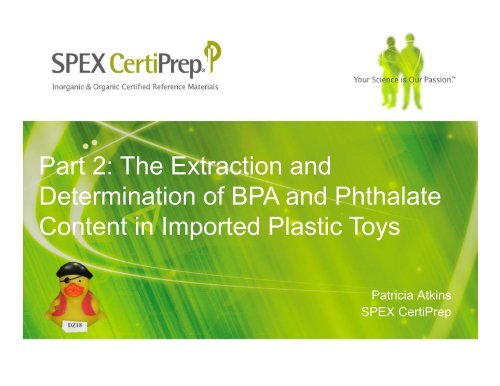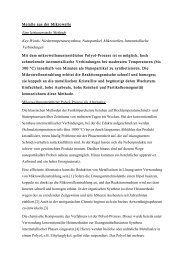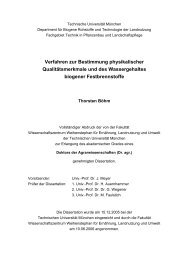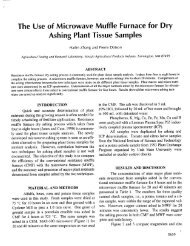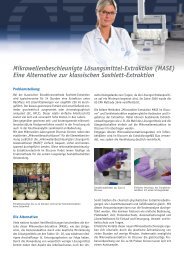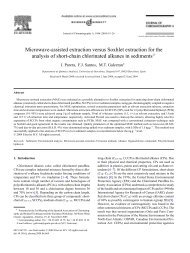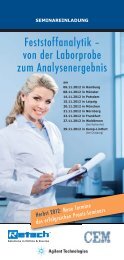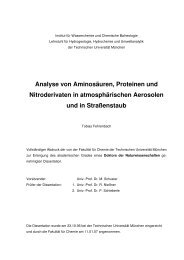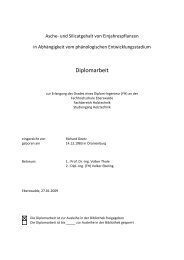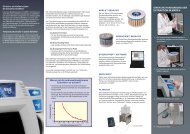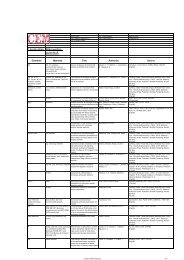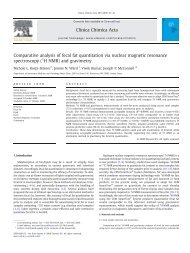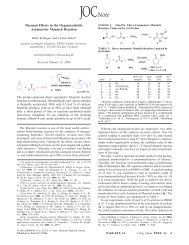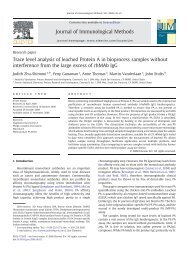Part 2: The Extraction and Determination of BPA and Phthalate ...
Part 2: The Extraction and Determination of BPA and Phthalate ...
Part 2: The Extraction and Determination of BPA and Phthalate ...
You also want an ePaper? Increase the reach of your titles
YUMPU automatically turns print PDFs into web optimized ePapers that Google loves.
<strong>Part</strong> 2: <strong>The</strong> <strong>Extraction</strong> <strong>and</strong><br />
<strong>Determination</strong> <strong>of</strong> <strong>BPA</strong> <strong>and</strong> <strong>Phthalate</strong><br />
Content in Imported Plastic Toys<br />
Patricia Atkins<br />
SPEX CertiPrep<br />
© SPEX CertiPrep, Inc. 2012<br />
1
Housekeeping<br />
� Everyone will receive a copy <strong>of</strong> the presentation slides<br />
� <strong>The</strong> webinar is being recorded <strong>and</strong> will be posted to our<br />
YouTube account<br />
� Questions will be answered at the end <strong>of</strong> the presentation<br />
– Type any questions you may have into the question box<br />
<strong>and</strong> we will answer them during the Q&A session<br />
� One lucky attendee will win <strong>The</strong>odore Gray’s <strong>The</strong> Elements<br />
Card Deck!<br />
© SPEX CertiPrep, Inc. 2012
<strong>Phthalate</strong>s Still A Topic <strong>of</strong> Concern<br />
http://www.sciencedaily.com/releases/2012/05/120523102142.htm<br />
© SPEX CertiPrep, Inc. 2012
Common <strong>Phthalate</strong>s<br />
Name Acronym Structural formula CAS No.<br />
Dimethyl phthalate DMP C 6H 4(COOCH 3) 2 131-11-3<br />
Diethyl phthalate DEP C6H4(COOC2H5) 2 84-66-2<br />
Diallyl phthalate DAP C6H4(COOCH2CH=CH2) 2 131-17-9<br />
Di-n-propyl phthalate DPP C6H4[COO(CH2) 2CH3] 2 131-16-8<br />
Di-n-butyl phthalate DBP C6H4[COO(CH2) 3CH3] 2 84-74-2<br />
Diisobutyl phthalate DIBP C6H4[COOCH2CH(CH3) 2] 2 84-69-5<br />
Butyl cyclohexyl phthalate BCP CH3(CH2) 3OOCC6H4COOC6H11 84-64-0<br />
Di-n-pentyl phthalate DNPP C6H4[COO(CH2) 4CH3] 2 131-18-0<br />
Dicyclohexyl phthalate DCP C6H4[COOC6H11] 2 84-61-7<br />
Butyl benzyl phthalate BBP CH3(CH2) 3OOCC6H4COOCH2C6H5 85-68-7<br />
Di-n-hexyl phthalate DNHP C6H4[COO(CH2) 5CH3] 2 84-75-3<br />
Butyl decyl phthalate BDP CH3(CH2) 3OOCC6H4COO(CH2) 9CH3 89-19-0<br />
Di(2-ethylhexyl) phthalate DEHP C 6H 4[COOCH 2CH(C 2H 5)(CH 2) 3CH 3] 2 117-81-7<br />
Di(n-octyl) phthalate DNOP C6H4[COO(CH2) 7CH3] 2 117-84-0<br />
Diisodecyl phthalate DIDP C6H4[COO(CH2)7CH(CH3)2]2 26761-40-0<br />
n-Octyl n-decyl phthalate ODP CH 3(CH 2) 7OOCC 6H 4COO(CH 2) 9CH 3 119-07-3<br />
Diisononyl phthalate DINP C 6H 4[COO(CH 2) 6CH(CH 3) 2] 2 28553-12-0<br />
© SPEX CertiPrep, Inc. 2012
Common <strong>Phthalate</strong>s<br />
Name Acronym Structural formula CAS No.<br />
Di-n-butyl phthalate DBP C 6H 4[COO(CH 2) 3CH 3] 2 84-74-2<br />
Butyl benzyl phthalate BBP CH 3(CH 2) 3OOCC 6H 4COOCH 2C 6H 5 85-68-7<br />
Di(2-ethylhexyl) phthalate DEHP C 6H 4[COOCH 2CH(C 2H 5)(CH 2) 3CH 3] 2 117-81-7<br />
Di(n-octyl) phthalate DNOP C 6H 4[COO(CH 2) 7CH 3] 2 117-84-0<br />
Diisodecyl phthalate DIDP C6H4[COO(CH2)7CH(CH3)2]2 26761-40-0<br />
Diisononyl phthalate DINP C 6H 4[COO(CH 2) 6CH(CH 3) 2] 2 28553-12-0<br />
© SPEX CertiPrep, Inc. 2012
Common <strong>Phthalate</strong>s<br />
Compound Uses<br />
DMP Insect repellent, plastic<br />
DEP Shampoo, scents, soap, lotion, cosmetics, industrial solvent, medications<br />
DBP Adhesives, caulk, cosmetics, industrial solvent, medications<br />
DIBP Adhesives, caulk, cosmetics, industrial solvent<br />
BBP Vinyl flooring, adhesives, sealants, industrial solvent<br />
DCHP Stabilizer in rubber, polymers<br />
DEHP S<strong>of</strong>t plastic, including tubing, toys, home products, food containers, food packaging<br />
DOP S<strong>of</strong>t plastic<br />
DINP S<strong>of</strong>t plastics, replacement for DEHP<br />
<strong>Phthalate</strong>s <strong>and</strong> Cumulative Risk Assessment <strong>The</strong> Task Ahead (2008)<br />
Board on Environmental Studies <strong>and</strong> Toxicology (BEST)<br />
© SPEX CertiPrep, Inc. 2012
Children & Exposure to <strong>Phthalate</strong>s<br />
� Medical Devices: may contain 20-40% DEHP by weight<br />
� Medication: coatings<br />
� Childcare Products<br />
• Ointments<br />
• Lotions<br />
• Shampoos<br />
� Childcare Articles<br />
• Pacifiers<br />
• Bottles<br />
• Plates<br />
• Spoons<br />
� Toys<br />
© SPEX CertiPrep, Inc. 2012
Regulations & Banned <strong>Phthalate</strong>s<br />
US<br />
CPSIA<br />
CPSC-CH-C1001-09.03<br />
EU EC Directive 2005/84/EC<br />
Japan<br />
ST St<strong>and</strong>ard <strong>Part</strong> 3 /<br />
Food Sanitation Law<br />
DEHP DBP BBP DINP DIDP DNOP<br />
0.1%<br />
individual<br />
(All toys &<br />
Childcare)<br />
0.1%<br />
individual<br />
(All toys &<br />
Childcare)<br />
0.1% combined<br />
(All toys)<br />
0.1% combined<br />
(All toys)<br />
0.1%<br />
individual<br />
(All toys &<br />
Childcare)<br />
0.1%<br />
individual<br />
(Oral Contact)<br />
0.1%<br />
individual<br />
(Oral Contact)<br />
0.1% combined<br />
(Toys with Oral Contact)<br />
0.1% combined<br />
(Toys with Oral Contact)<br />
© SPEX CertiPrep, Inc. 2012<br />
0.1%<br />
individual<br />
(Oral Contact)
Infant & Children’s Exposure to<br />
<strong>BPA</strong><br />
� Food & Food Packaging<br />
• Can linings & Containers<br />
• Baby Bottles<br />
• up to 13 µg/kg <strong>of</strong> body wt/day<br />
• Water Bottles<br />
• Liquid Baby Formula<br />
• 0.48 to 11 ng/g<br />
� Paper: Receipts & Labels<br />
� PVC Pipes<br />
� Medical Devices<br />
� Toys<br />
� During Pregnancy<br />
• US study (2009): avg 2.8 ng/mL in 9/10<br />
umbilical cord bloods<br />
© SPEX CertiPrep, Inc. 2012
Regulations<br />
Area Scope <strong>of</strong> <strong>BPA</strong> Ban Requirement<br />
US Various childcare products<br />
No National Ban;<br />
State by State<br />
EU PC baby bottles Banned<br />
Canada<br />
PC baby bottles Banned<br />
<strong>BPA</strong> deemed toxic Action<br />
© SPEX CertiPrep, Inc. 2012
Toy Samples<br />
26 Toys from Discount or Dollar Stores<br />
Items with Oral<br />
Contact<br />
Items with Possible<br />
Oral Contact<br />
© SPEX CertiPrep, Inc. 2012
Sample Preparation: Grinding<br />
Cryogenic grinding allows for a fine analytical powder not possible with<br />
room temperature grinding<br />
© SPEX CertiPrep, Inc. 2012
Sample Identifications<br />
Type<br />
# <strong>of</strong><br />
Samples<br />
LDPE PVC 17 22<br />
LDPE PVC 17 22<br />
HDPE 6<br />
PC 7<br />
PP 2<br />
ABS 1<br />
Silicone 1<br />
Cloth 1<br />
© SPEX CertiPrep, Inc. 2012
Testing Method for <strong>Phthalate</strong>s<br />
CPSC-CH-C1001-09.03<br />
� St<strong>and</strong>ard Operating Procedure for<br />
<strong>Determination</strong> <strong>of</strong> <strong>Phthalate</strong>s<br />
(Children’s Toys & Childcare Articles)<br />
� Measurement <strong>of</strong> 6 Restricted<br />
<strong>Phthalate</strong>s<br />
� Outlines:<br />
• Sample Preparation<br />
• <strong>Extraction</strong><br />
• Analysis<br />
© SPEX CertiPrep, Inc. 2012
Sample <strong>Extraction</strong>: CPSC<br />
© SPEX CertiPrep, Inc. 2012
CPSC Wet <strong>Extraction</strong> Method: PVC<br />
� Intended for PVC not other materials<br />
� For 0.05 g = 15 mL solvent minimum<br />
• PVC Toy samples don’t always<br />
precipitate with 15 mL<br />
• Increased solvent dilutes sample<br />
� At the CPSC limit (0.1% or 1000 µg/g)<br />
• Straight GC injection = 3 ppm<br />
• Diluted per method = 0.7 ppm<br />
o SIM Mode<br />
• Miss other additives<br />
• Misidentify other additives<br />
as phthalates<br />
• Miss low level phthalates<br />
or <strong>BPA</strong><br />
� What is the extraction efficiency <strong>of</strong> the<br />
method?<br />
© SPEX CertiPrep, Inc. 2012
CPSC Wet <strong>Extraction</strong> Method: PVC<br />
� SPEX CertiPrep CRM-PE001:<br />
Polyethylene Matrix<br />
• Recovery for PE material<br />
using PVC wet method =<br />
50%<br />
� New CRM developed for PVC<br />
• Recovery for CPSC Method<br />
= 83 – 94%<br />
• Poor Reproducibility<br />
• GC Contamination<br />
<strong>Phthalate</strong> CPSC Wet Method<br />
%RSD<br />
Dimethyl phthalate 35.09<br />
Diethyl phthalate 36.96<br />
Di-n-butyl phthalate 48.42<br />
Butyl benzyl phthalate 57.72<br />
Bis(2-ethylhexyl)phthalate 58.05<br />
Di-n-octyl phthalate 58.24<br />
Diisononyl phthalate 50.97<br />
Diisodecyl phthalate 60.69<br />
© SPEX CertiPrep, Inc. 2012
Microwave Method Optimization<br />
� Methods Developed by CEM<br />
• HDPE method: Cyclohexane: Acetone (Recovery >95%)<br />
• LDPE method: IPA solvent<br />
• PVC method: Ether<br />
o Did not want to run ether<br />
o Possible dissolution <strong>of</strong> PVC with Acetone<br />
� Goal was not to dissolve polymer<br />
Temp ºC Cyclohexane IPA Acetone Solubility % Recovery<br />
130 50 - 50 Dissolved NA<br />
130 80 - 20 Dissolved NA<br />
100 80 - 20 <strong>Part</strong>itioned/Slightly dissolved 91-101<br />
100 80 20 - Not dissolved 86-98<br />
130 80 20 - Not dissolved 93-100<br />
150 80 20 - Dissolved NA<br />
130 50 50 - Not dissolved 95-105<br />
150 50 50 - Not dissolved 99-102<br />
© SPEX CertiPrep, Inc. 2012
<strong>Extraction</strong> Methods<br />
HDPE<br />
Microwave <strong>Extraction</strong><br />
� 10 mL Cyclohexane:<br />
Acetone (30:70)<br />
� 0.2 g sample<br />
� Ramp to Temperature<br />
• 10 minutes to 140 ºC<br />
• Hold 10 minutes<br />
� Stirring used<br />
PVC<br />
Microwave <strong>Extraction</strong><br />
� 10 mL Cyclohexane: IPA<br />
(50:50)<br />
� 0.2 g sample<br />
� Ramp to Temperature<br />
• 10 minutes to 130 ºC<br />
• Hold 10 minutes<br />
� Stirring used<br />
© SPEX CertiPrep, Inc. 2012
CEM Applications Support<br />
www.cem.com<br />
© SPEX CertiPrep, Inc. 2012
Comparison <strong>of</strong> CPSC Wet Method<br />
vs. Microwave <strong>Extraction</strong> for PVC<br />
THF Wet Method<br />
� Large amounts <strong>of</strong> solvent<br />
� Less concentration on GCMS<br />
system: miss some additives<br />
� Interference <strong>of</strong> polymers with<br />
GCMS operation<br />
� Poor reproducibility<br />
� Time consuming<br />
Microwave Method<br />
� 10 – 15 mL <strong>of</strong> solvent for up to 1 g<br />
<strong>of</strong> sample<br />
� Allows high enough concentration<br />
<strong>of</strong> small phthalates to see on<br />
GCMS<br />
� Dilution possible for higher<br />
concentration phthalates<br />
� Little interference/carryover seen<br />
on GCMS<br />
� Great reproducibility<br />
� Fast, multiple samples processed<br />
at once<br />
© SPEX CertiPrep, Inc. 2012
Comparison <strong>of</strong> CPSC Wet Method<br />
vs. Microwave <strong>Extraction</strong><br />
<strong>Phthalate</strong><br />
Optimized Microwave Method<br />
%RSD<br />
CPSC Wet Method<br />
%RSD<br />
Dimethyl phthalate 2.48 35.09<br />
Diethyl phthalate 0.72 36.96<br />
Di-n-butyl phthalate 0.70 48.42<br />
Butyl benzyl phthalate 2.26 57.72<br />
Bis(2-ethylhexyl)phthalate 1.02 58.05<br />
Di-n-octyl phthalate 1.29 58.24<br />
Diisononyl phthalate 0.36 50.97<br />
Diisodecyl phthalate 0.94 60.69<br />
© SPEX CertiPrep, Inc. 2012
Methods & Materials:<br />
Instrument Conditions<br />
� GC-MS in scan mode with EIC (35-450 m/z)<br />
� CV-5 capillary column (30 m x 0.25 mm x 0.25 µm)<br />
<strong>Phthalate</strong> Abbreviation Ions<br />
Di-n-butyl phthalate DBP 149, 150, 29, 41, 57<br />
Bisphenol A <strong>BPA</strong> 213, 228, 119, 214, 91<br />
Butyl benzyl phthalate BBP 149, 91, 206, 65, 104<br />
Di(2-ethylhexyl) phthalate DEHP 149, 167, 279, 71<br />
Di(n-octyl) phthalate DNOP 149, 279, 43, 57<br />
Dinonyl phthalate DINP 149, 293, 71, 57, 43<br />
Diisodecyl phthalate DIDP 149, 307, 71, 141<br />
© SPEX CertiPrep, Inc. 2012
HDPE Toys<br />
� Plastic Figures<br />
• Police<br />
• Military<br />
• Fireman<br />
� Toy Car <strong>Part</strong>s<br />
• Black Base<br />
• Black Wheel<br />
• Silver parts<br />
© SPEX CertiPrep, Inc. 2012
Results: HDPE Toys<br />
� One restricted<br />
phthalate<br />
• DNOP<br />
• < 0.1% (1000 µg/g)<br />
� No <strong>BPA</strong><br />
� Wheel<br />
• Higher Alkanes<br />
Concentration (µg/g)<br />
140.00<br />
120.00<br />
100.00<br />
80.00<br />
60.00<br />
40.00<br />
20.00<br />
0.00<br />
Di-n-octyl phthalate (µg/g)<br />
Black Car<br />
Military<br />
GI Silver Car<br />
Base <strong>Part</strong><br />
<strong>Part</strong><br />
Police Fireman Black Car<br />
Wheel<br />
Toy Sample<br />
© SPEX CertiPrep, Inc. 2012
PVC Toys<br />
Without Oral Contact Possible Oral Contact<br />
© SPEX CertiPrep, Inc. 2012
PVC Toys: DEHP<br />
DEHP (µg/g)<br />
30000.00<br />
25000.00<br />
20000.00<br />
15000.00<br />
10000.00<br />
5000.00<br />
0.00<br />
US limit 1000 µg/g<br />
Total DEHP in each toy sample<br />
Toy Sample<br />
© SPEX CertiPrep, Inc. 2012
PVC Toys: DINP, DIDP, DNOP<br />
Concentration (µg/g)- log scale<br />
1000000.00<br />
100000.00<br />
10000.00<br />
1000.00<br />
100.00<br />
10.00<br />
1.00<br />
US limit 1000 µg/g<br />
DNOP<br />
DINP<br />
DIDP<br />
Orange Snake Pink Snake Green Snake Donkey Grey Shark Blue Shark Snorkel<br />
Mouthpiece<br />
Toy Sample<br />
© SPEX CertiPrep, Inc. 2012
PVC Toys: Total <strong>Phthalate</strong>s<br />
Total <strong>of</strong> 6 restricted phthalates (µg/g) – log scale<br />
1000000.00<br />
100000.00<br />
10000.00<br />
1000.00<br />
100.00<br />
10.00<br />
1.00<br />
Total Concentration <strong>of</strong> Six Restricted <strong>Phthalate</strong>s in Each Toy Sample<br />
EU/Japan limit 1000 µg/g<br />
US limit 6000 µg/g<br />
Toy Sample<br />
© SPEX CertiPrep, Inc. 2012
Results: <strong>BPA</strong><br />
Conc <strong>of</strong> <strong>BPA</strong> (µg/g)<br />
1400.00<br />
1200.00<br />
1000.00<br />
800.00<br />
600.00<br />
400.00<br />
200.00<br />
0.00<br />
Concentration <strong>of</strong> <strong>BPA</strong> in Selected Toy Samples<br />
Triceratops Duck Doll Head<br />
Toy Sample<br />
© SPEX CertiPrep, Inc. 2012
Results: Other Compounds<br />
100<br />
50<br />
29<br />
41<br />
57<br />
60 69<br />
111<br />
87 102<br />
129<br />
147 157<br />
185<br />
0<br />
20 40 60 80 100 120 140 160 180 200 220 240 260 280 300 320 340 360<br />
(mainlib) Butyl citrate<br />
100<br />
50<br />
29<br />
43<br />
57<br />
129<br />
157<br />
185<br />
61 84<br />
112 139<br />
147<br />
168<br />
213<br />
231<br />
273<br />
329<br />
0<br />
20 40 60 80<br />
(mainlib) Tributyl acetylcitrate<br />
100 120 140 160 180 200 220 240 260 280 300 320 340 360 380<br />
© SPEX CertiPrep, Inc. 2012<br />
400<br />
203 213<br />
O O<br />
259<br />
O<br />
259<br />
HO<br />
O<br />
O<br />
O<br />
O<br />
O<br />
O<br />
O<br />
O<br />
O<br />
O<br />
O
Results: Other Compounds<br />
� Alternative Plasticizers<br />
• Butyl Citrate<br />
• Tributyl Acetyl Citrate<br />
� Measurable levels in 9 <strong>of</strong> 17 toys<br />
• Large % amounts <strong>of</strong> either one or<br />
both = 7 toys<br />
• Highest amounts <strong>of</strong> BC & ATBC=<br />
Lion<br />
© SPEX CertiPrep, Inc. 2012
Conclusions: PVC Toys<br />
� DBP & BBP: CPSC limit <strong>of</strong> 0.1% DEHP<br />
© SPEX CertiPrep, Inc. 2012
Conclusions: PVC Toys<br />
Highest Amounts <strong>of</strong> DEHP<br />
28000 µg/g 25000 µg/g 21000 µg/g 14000 µg/g<br />
Lowest Amounts <strong>of</strong> DEHP<br />
• No phthalates but % <strong>of</strong> alternate plasticizers<br />
• Tributyl Acetyl Citrate<br />
• Butyl Citrate<br />
© SPEX CertiPrep, Inc. 2012
Conclusions: PVC Toys<br />
� Total <strong>Phthalate</strong>s<br />
• Highest total<br />
• Donkey (DIDP & DINP)<br />
• Oral Contact Toys<br />
• Snorkel mouthpiece (> limit)<br />
• Possible Oral Contact Toys<br />
• Duck (DEHP & <strong>BPA</strong>)<br />
� Bisphenol A<br />
• Detected in 3 <strong>of</strong> 17 toys<br />
• Up to 1200 µg/g (Doll Head)<br />
© SPEX CertiPrep, Inc. 2012
Conclusions<br />
� HDPE Toys contained low amounts <strong>of</strong><br />
phthalates<br />
• Only DNOP detected (< limit)<br />
• Higher alkanes seen for one toy part<br />
� PVC toys<br />
• Most <strong>of</strong> the toys contained large amounts<br />
<strong>of</strong> DEHP > all limits<br />
• Some PVC toys also contained DINP,<br />
DIDP <strong>and</strong> DNOP<br />
• <strong>BPA</strong> detected possible oral contact toys:<br />
Duck & Doll Head<br />
• 50% <strong>of</strong> PVC toys contained % quantities<br />
<strong>of</strong> alternate plasticizers<br />
� Further studies planned on the other<br />
polymer toys<br />
© SPEX CertiPrep, Inc. 2012
St<strong>and</strong>ards Used in This Study<br />
<strong>Phthalate</strong> & <strong>BPA</strong> St<strong>and</strong>ards from SPEX CertiPrep:<br />
� S-509: Bisphenol A St<strong>and</strong>ard<br />
� CRM-PE001: PE QC St<strong>and</strong>ard<br />
� CRM-PEBLK: PE Blank<br />
� CRM-PVC001: PVC QC St<strong>and</strong>ard<br />
� CRM-PVCBLK: PVC Blank<br />
� CLPS-1: Internal St<strong>and</strong>ards<br />
© SPEX CertiPrep, Inc. 2012
Thanks<br />
�SPEX CertiPrep Chemists<br />
�CEM Corporation<br />
© SPEX CertiPrep, Inc. 2012
CEM Applications Support<br />
� For Applications Support<br />
– Email: analytical.support@cem.com<br />
– Phone: 800-726-3331<br />
� For Sales Support<br />
– Email: info@cem.com<br />
– Phone: 800-726-3331<br />
© SPEX CertiPrep, Inc. 2012
Questions?<br />
Additional questions can be sent to<br />
CRMSales@spex.com<br />
© SPEX CertiPrep, Inc. 2012
New Products<br />
� Full line <strong>of</strong> 1 ppm ICP-MS<br />
Single Element St<strong>and</strong>ards<br />
Visit www.spexcertiprep.com for<br />
more information<br />
� Trace Metals in Natural Wine<br />
Matrix St<strong>and</strong>ards<br />
– Red: TM-WINE-R1A<br />
– White: TM-WINE-W1A<br />
© SPEX CertiPrep, Inc. 2012
Free Drawing!<br />
<strong>The</strong> Photographic<br />
Card Deck <strong>of</strong> the<br />
Periodic Table<br />
By <strong>The</strong>odore Gray<br />
© SPEX CertiPrep, Inc. 2012
Thank You!<br />
Contact Us!<br />
Pat Atkins<br />
Matt Snyder<br />
CRMSales@spex.com<br />
© SPEX CertiPrep, Inc. 2012


